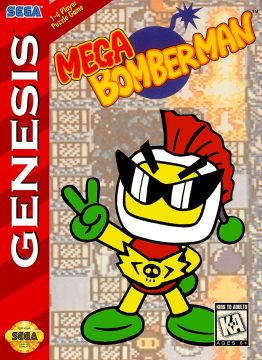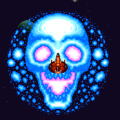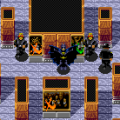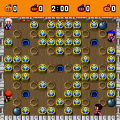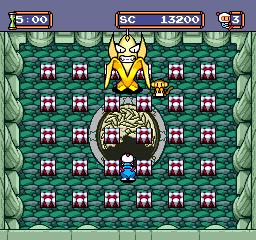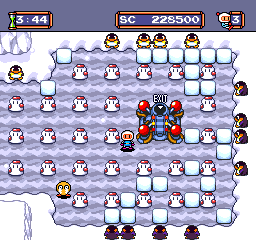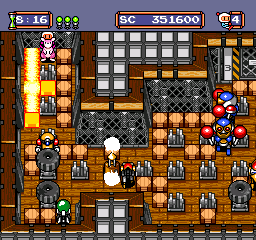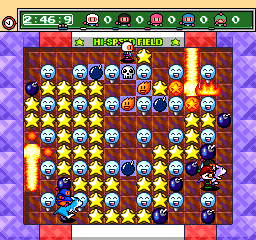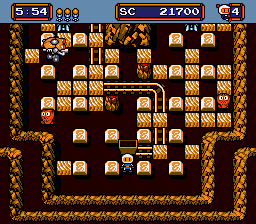- Bomberman Series Introduction / Bomberman (1983)
- 3-D Bomberman
- Bomberman (1985)
- RoboWarrior
- Atomic Punk
- Bomberman (1990)
- Atomic Punk (Arcade)
- Bomberman II
- New Atomic Punk: Global Quest
- Bomberman ’93
- Super Bomberman
- Hi-Ten Bomberman / Hi-Ten Chara Bomb
- Bomberman ’94 / Mega Bomberman
- Super Bomberman 2
- Super Bomberman 3
- Wario Blast: Featuring Bomberman
- Bomberman GB 2
- Bomberman: Panic Bomber
- Super Bomberman 4
- Saturn Bomberman
- Bomberman GB 3
- Bomberman B-Daman
- Super Bomberman 5
- Atomic Bomberman
- Neo Bomberman
- Amazing Bomberman
- Bomberman 64
- Saturn Bomberman Fight!!
- Pocket Bomberman
- Super Bomberman R
- Super Bomberman R Online
Even with the success of Super Bomberman overseas, Hudson Soft had different plans for the next 1993 entry. Bomberman ’94 brings the series back to the PC Engine and is the first entry to (initially) release as a Japan exclusive since 3-D Bomberman. This was likely due to the fact that the PC Engine underperformed outside of Japan, though the platform would be discontinued everywhere in 1994 regardless. To better accommodate overseas markets, the game was ported to the Mega Drive as Mega Bomberman in 1994, so its Japanese exclusivity technically didn’t last long. As the final main series entry on the PC Engine, Bomberman’94 specifically picks up where Bomberman ’93 left off and refines it to a striking degree, making for a worthy sendoff for the platform.
Bomberman ’94 changes the Bomberman canon once again, but the story elements established in this game set a proper foundation for several future entries. The game takes place on Planet Bomber, the soon-to-be consistent home for the Bombers, and tells the story of its five spirits, which power the planet through magic generated from the five “Spirit Pictures”. Newcomer villain Bagura invades Planet Bomber with an army in tow and destroys the Spirit Pictures, causing the planet to split into five pieces. As always, White Bomberman sets out to save the day, though this time around there’s no option for Black Bomberman to join the fray, one of several elements of Super Bomberman that is neglected here. Unlike Carat Diamond, Bagura is used as a recurring villain throughout many entries in the franchise, though oftentimes with his name translated differently per game.
Much of Bomberman ’94 is built upon the foundation of its PC Engine predecessor, but a lot has been done to alter the structure and progression of the game compared to prior entries. The game still takes place over the course of multiple areas, but each area has fewer levels that are significantly larger and oftentimes broken up into multiple parts divided by doors that need to be opened. This change gives Bomberman ‘94 the smallest level count yet, but the enlarged scope of each level results in an ultimately similar runtime to past entries.
Levels have more elaborate structures this time around too, frequently breaking free of the typical square and rectangular constraints the series is so fond of, and contain various new tricks to keep things fresh. The second area is littered with volcanoes that shoot fireballs that stun Bomberman if they make contact. Mine carts are also present and Bomberman can use them to tear through enemies or make it to otherwise inaccessible areas. The fourth area has sections shrouded in complete darkness that force you to move slowly since Bomberman can only see directly in front of him. The eyes of your enemies are still visible though, cleverly allowing players to identify enemies based on the shape of their eyes. Area five features igloos that you can blow the tops off of as well as penguins that launch rockets indiscriminately, encouraging you to get out of there before you’re caught in a bad spot.
Most importantly, destroying every foe and finding the exit is no longer your objective. Instead, your goal is to destroy the mechanisms that power the barriers containing the Spirit Picture pieces you need to reform the planet. This gives the game a more variable pace, allowing players to decide how much they want to explore and engage with a given level. Players who haven’t acquired a full arsenal just yet will likely want to play as usual, destroying everything in sight, whereas those who are doing well and haven’t died are incentivized to focus on the objective. Minimizing your destruction is also rewarded in its own way; once you’ve collected a level’s Spirit Picture piece, every remaining soft block is transformed into a coin and you’re given 15 seconds to pick them up. These coins are the best way to earn points that lead to 1-ups, so this allows powered up players to further press their advantage with a bounty of extra lives.
Bomberman ’94 is also the most open-ended entry since Atomic Punk on the Game Boy. Levels in an area can be played in any order and it’s also possible to replay completed levels if you wish to stockpile points or power-ups. This isn’t something that’s necessary at all, since most levels have plenty of power-ups to go around and the overall difficulty is lower than Bomberman ‘93, but offering the option at all is nice and suggests that Hudson Soft was still looking to experiment with ways to broaden the scope of the franchise’s single player modes.This feature is partially cut back in Mega Bomberman, which allows you to revisit levels but not tackle them out of order.
The other major feature this game offers is the introduction of Bomberman’s first animal friend, the rabbit/kangaroo-like Rooi (or Louie, as it was translated to in Mega Bomberman). These lovable critters are the Yoshi to Bomberman’s Mario, serving as both a way to take an extra hit and as a way to give Bomberman an additional ability. Louies are found in eggs hidden in soft blocks and the color of the Louie determines its ability. The purple Louie can jump in order to pass over blocks and avoid attacks with good timing. The green Louie quickly dashes until it hits a wall with the press of a button, allowing for hit and run maneuvers that can clear a stage in a flash in the right hands. The boxing glove from Super Bomberman has been replaced by the Blue Louie, which punts bombs a few spaces forward. An entirely new ability is introduced through the Yellow Louie, who can kick soft blocks in order to move them around, giving the player an entirely new way to manipulate levels. Last but certainly not least is the pink Louie; until you let go of the action button, the pink Louie will continue to dance in place. It doesn’t do anything, but at least it’s pretty cute! Louies also appear in the multiplayer mode, providing a significant new asset for players to use against each other and are something that you’ll always want to beeline for.
Bomberman’94 is one of the franchise’s best looking and most charming games thus far. Hudson Soft has had years to refine their craft and make use of the PC Engine’s capabilities, and that really shows here. Environments are more detailed than ever, featuring more elaborate background elements and more detailed floor textures. Area three is a particular highlight, combining a constant ripple effect with fish that swim across the screen to create an environment that immerses the player in the beauty of the ocean. In terms of enemy types, a lot of robotic enemies similar to the ones seen in Super Bomberman are used here, but they’re supplemented with plenty of goofy foes to keep things more varied than that game was. The bosses here may be easier than in Bomberman ’93, but their designs are top notch to make up for it – the first boss is a monkey that remote controls a giant, angry banana!
Battle mode this time around doesn’t offer quite as many stages as Super Bomberman (ten levels compared to that game’s 12), but it is the first console entry to offer team battles as an option. Battle mode allows for up to five players, so teams will always be uneven if all five players are present, which is something that Mega Bomberman happens to fix with its four player limit. The other big change here is the option to select one of nine different avatars to play as. These characters are purely cosmetic if a human is controlling them, but when they’re controlled by AI, the selected character determines how the AI plays. For example, Big Bomber will intentionally prioritize items above all else, Construction Bomber is more interested in destroying soft blocks than he is other players, and Kamikaze Bomber always chooses violence by placing bombs everywhere with reckless abandon. This is a smarter, more immediately intuitive way to determine AI behavior than Super Bomberman’s ten AI levels, so it’s a shame that it isn’t a consistent feature throughout the franchise. It’s also worth noting that this is the first entry to establish a female Bomber in the form of Bomber Lady, setting the precedent for Bombers to be more than just the standard Bomberman we’ve all come to know and love. The arena gimmicks are mostly ones that will ring familiar to those who have played past games, but some of the new ideas include an area that doesn’t have any soft blocks but grants players maximum firepower to compensate, an arena with plant overgrowth that can be hidden beneath, and a battlefield littered with arrows that can change the direction of kicked bombs.
Bomberman ’94 is among the most frequently ported entries in the franchise and is still available on platforms such as the Wii U Virtual Console, the PlayStation Network, and even the Windows App Store. Its 2009 release on the Wii’s Virtual Console is particularly notable for being the first time a version that wasn’t Mega Bomberman was made available outside of Japan. A mobile version that was part of the TurboGrafx-16 GameBoxemulator was made available in 2010 for iOS devices, but has since been delisted. The game was also featured on all versions of the PC Engine Mini in 2020.
Mega Bomberman originally started as a pitch for an entirely new entry that would be developed by Factor 5, the team responsible for the beloved Turrican series. As a proof of concept, Factor 5 managed to create an 8-player Bomberman demo that was playable with two Sega Team Player adapters. For reasons unknown, Hudson Soft ended up rejecting the pitch and instead opted for a straightforward port of Bomberman ’94, for which they would hire Westone, the developers of Wonder Boy. The Factor 5 prototype is available online and is a fascinating look into what could have been. The prototype only offers one stage, no settings, a few items, and a chubby design for Bomberman, but the fact it exists at all is impressive. Bizarrely, there’s no way to actually end a round since the game will keep going even when one player is left standing.
Despite being a straight port, Mega Bomberman has many differences as a result of the move over to the Mega Drive. The most obvious difference is that Mega Bomberman features a smaller and duller color palette, hampering the impeccable design work of the original team. Colors are darker, the floors are mostly flat textures, and various details are missing, such as Bomberman sleeping when the game is paused. The beautiful visual effects in area three are completely gone, it no longer snows in area five, and the darker color palette makes it very difficult to spot where the fireballs in area two are landing. Mega Bomberman also suffers from minor slowdown in crowded areas that ran flawlessly on the PC Engine, such as the mine cart sections in area two.
In terms of changes that aren’t explicitly for the worse, the music has been adapted to the Mega Drive’s sound chip and the first two areas have new music tracks that play to the chip’s particular strengths. If you’re a fan of the unique sound of the Mega Drive, Mega Bomberman’s soundtrack is an improvement since it gives the soundtrack a more distinct identity as the first game in the series to utilize such a different and harsh sound font. All of the areas have been given new names in Mega Bomberman and each uses a cute alliterative title to try and replicate the wordplay present in the original titles while adding a bit of that 90s attitude western territories loved at the time. MoriMori Forest has become Jammin’ Jungle, Mount AchiAchi is Vexin’ Volcano, BukuBukuBeach is now Slammin’ Sea, KuraKura Castle was changed to Crankin’ Castle, and YukiYuki Land is Thrashin’ Tundra.
Like with Bomberman ’93, a Special Version was offered at Hudson Soft events as well as through a newsletter in small quantities estimated to be around 10,000 units. Despite being an appetizer for the full game, the Special Version was a CD game instead of a HuCard, though it doesn’t put the new storage medium to use since it just reuses music from Bomberman ’93. Battle mode is once again the only option present (with only one stage) and many of the bells and whistles of the full game, such as the selectable characters and the ability to play against AI, are not available here.
Another promotional version of the game, Tengai Makyou: Deden no Den, was made available as a prize for participating in Hudson Soft’s 1993 Super Caravan event and also through a 1994 newsletter. As the name implies, this game is the same as the Special Version except Bomberman has been replaced with Kabuki Danjirou from the Tengai Makyou series. For whatever reason, this version has a cheat code that allows for five stages to be played instead of one.
In 2008, another port of the game was made available on Japanese phones (the FOMA903i and FOMA703i series specifically) in the form of Bomberman ’08. This version is mostly the same as the PC Engine version but makes a few changes to accommodate the new platform and put it more in line with where the series was at that time. Unlike Mega Bomberman, this version retains all of the visuals of the original game except for area three’s rippling water effect. Bomberman, Louie, and Bagura all have slightly updated designs based on their most recent appearances at the time. The credits sequence had to be scaled down, though, so it offers less animation alongside the removal of Louie and the bosses who previously showed up during it. A save system was also added to replace the passwords of the previous versions, something that’s more suited to portable play. All in all, this is a very impressive version considering the time in which it was released and while it’s a bit difficult to play, a translated version is available for those who want to give it a spin.
Links
https://www.youtube.com/watch?v=nSumFRlGV2I – Full playthrough of Bomberman ‘08
https://www.microsoft.com/en-us/p/bomberman94/9wzdncrdf3t4?activetab=pivot:overviewtab – Link to the Windows App version
https://www.gamedeveloper.com/pc/hudson-releases-i-turbografx-16-gamebox-i-emulator-for-ios – Article about the TurboGrafx-16 GameBox emulator
http://randomhoohaas.flyingomelette.com/bomb/pce-94/sp.html – Information on the Special Version and Tengai Makyou: Deden no Den


